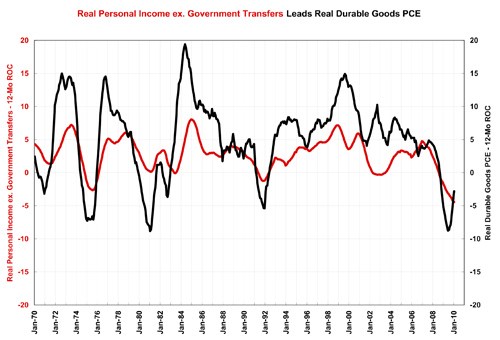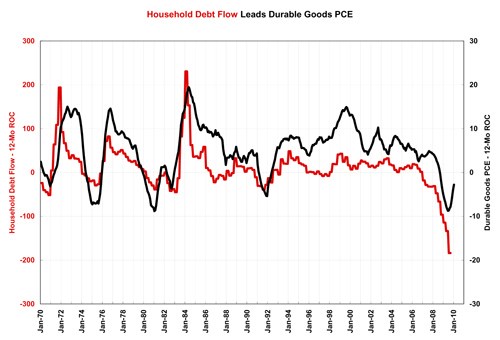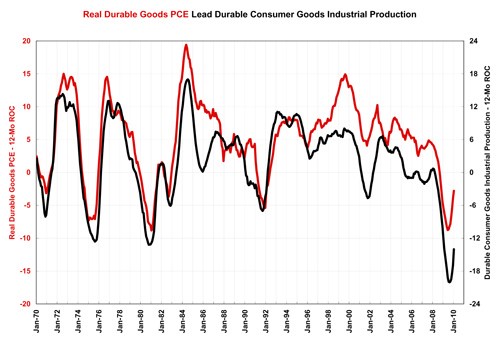Real personal income includes all job-related income, dividends, rental income and more. However, I exclude government transfers (such as unemployment benefits, Social Security payments and more) from my analysis because they are not earned income but simply a transfer of income from group to another. Therefore, these transfers don’t provide truly additional money for spending.
In January, real personal income excluding government transfers was 3.0% less than in January 2009, according to the Bureau of Economic Analysis. This measure of income has fallen 6.9% from its peak in September 2007. Since it bottomed in September 2009, real personal income excluding government transfers is up just 0.2%. The first chart also shows the 12-month rate of change curve I use to show that income is a leading indicator for consumer durable goods spending. The rate of change curve shows that incomes are contracting faster year over year each month. The rate of contraction is easily the fastest in the last 40 years.
While income has been virtually flat since June 2009, consumer spending on durable goods has been growing. In fact, spending on durable goods grew 4.6% in January compared to January 2009. From its peak in November 2007, consumer durable goods spending fell 6.7% (almost exactly the same percentage as the income decline mentioned previously). However, spending is up 7.4% from its bottom in April 2009. The second chart shows actual consumer durable goods spending as well as the 12-month rate of change. The rate of change curve shows that while spending on durable goods is still contracting, it is doing so more slowly year over year each month.
So, if income, a leading indicator for spending (see the third chart), is still falling, how can spending be going up? Perhaps consumers are using debt to make up for the lack of income to buy durable goods. This is not the case because household debt flow is contracting at its fastest rate in the last 40 years (see the fourth chart). So, if the two sources (income and debt) in which people get money to buy durable goods are falling, how is spending going up? The first thought is that people are getting money from some other means – like government transfers. But, even if we include government transfers in real personal income, income was still lower in January 2010 than it was in January 2009. The second thought is perhaps that the seasonal adjustments the government applies to consumer durable goods spending are not capturing the actual changes in consumer behavior this economic cycle, causing an over-reporting of spending. This could be possible because even though spending has been increasing sales tax receipts have been decreasing.
Whatever the reason, the correlation of the last 40 years between income (and debt) and spending has broken. This is something that cannot go on forever. So, either income needs to start growing, or spending will begin contracting. I’m watching this trend very closely because consumer spending on durable goods is an excellent leading indicator for consumer durable goods industrial production (see the fifth chart). Consumer durable goods industrial production is a good proxy for the health of the metalworking industry.
For a recent article I wrote on industrial production go
here.

.JPG;width=70;height=70;mode=crop)








.png;maxWidth=300;quality=90)









.png;maxWidth=300;quality=90)



